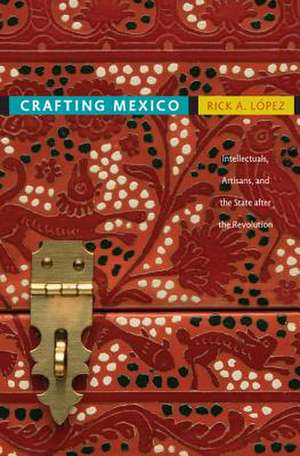Crafting Mexico – Intellectuals, Artisans, and the State after the Revolution
Autor Rick A. Lópezen Limba Engleză Paperback – 8 sep 2010
Preț: 279.52 lei
Nou
Puncte Express: 419
Preț estimativ în valută:
53.49€ • 55.73$ • 44.29£
53.49€ • 55.73$ • 44.29£
Carte indisponibilă temporar
Doresc să fiu notificat când acest titlu va fi disponibil:
Se trimite...
Preluare comenzi: 021 569.72.76
Specificații
ISBN-13: 9780822347033
ISBN-10: 0822347032
Pagini: 424
Ilustrații: 16 color illustrations, 23 b&w, 1 map
Dimensiuni: 156 x 234 x 30 mm
Greutate: 0.64 kg
Ediția:New.
Editura: MD – Duke University Press
ISBN-10: 0822347032
Pagini: 424
Ilustrații: 16 color illustrations, 23 b&w, 1 map
Dimensiuni: 156 x 234 x 30 mm
Greutate: 0.64 kg
Ediția:New.
Editura: MD – Duke University Press
Cuprins
List of Illustrations; AcknowledgmentsIntroduction: Nation Formation, Popular Art, and the Search for a Mexican AestheticPart I: Indianness and the Postrevolutionary Mexican Nation1 Ethnicizing the Nation: The India Bonita Contest of 1921; 2 Popular Art and the Staging of Indianness; 3 Foreign-Mexican Collaboration, 19201940; 4 The Postrevolutionary Cultural Project, 19161938; 5 The Museum and the Market, 19291948; 6 Formulating a State Policy toward Popular Art, 19371974Part II: Alternative Narratives of Metropolitan Intervention: The Artisans of Olinalá, Guerrero7 The Unbroken Tradition of Olinalá from the Aztecs through the Revolution; 8 Transnational Renaissance and Local Power Struggles, 1920s to 1950s; 9 The Road to Olinalá, 19351972ConclusionsNotes; Bibliography; Index
Recenzii
Crafting Mexico covers much new territory. Its linkage of local, national, and transnational history is exemplary. Mary Kay Vaughan, co-editor of The Eagle and the Virgin: Nation and Cultural Revolution in Mexico, 19201940In recent decades, historians of twentieth-century Mexico have reshaped the way we understand state and nation formationparticularly popular constructions of the nationaland the role that foreign actors have played in brokering Mexicos distinctive, transnational process of becoming modern. Crafting Mexico represents a culminating moment in these inquiries. Better than any study I know, it wrestles with the complex process whereby Mexico transformed itself from a fragmented society, driven by regional loyalties, linguistic and cultural particularism, and caudillo politics, into one of the hemispheres most unified nations. Part of the answer, Rick A. López argues masterfully, lies in a surprisingly contingent aesthetic and political process that embraced foreign and local actors, cosmopolitan intellectuals and indigenous crafts producers, and a panoply of state and private initiatives. Deftly integrating analytical and spatial dimensions, and bridging temporal boundaries, Crafting Mexico is a substantial achievement.Gilbert M. Joseph, co-editor of Fragments of a Golden Age: The Politics of Culture in Mexico since 1940
"Crafting Mexico covers much new territory. Its linkage of local, national, and transnational history is exemplary." Mary Kay Vaughan, co-editor of The Eagle and the Virgin: Nation and Cultural Revolution in Mexico, 1920-1940 "In recent decades, historians of twentieth-century Mexico have reshaped the way we understand state and nation formation--particularly popular constructions of the national--and the role that foreign actors have played in brokering Mexico's distinctive, transnational process of becoming modern. Crafting Mexico represents a culminating moment in these inquiries. Better than any study I know, it wrestles with the complex process whereby Mexico transformed itself from a fragmented society, driven by regional loyalties, linguistic and cultural particularism, and caudillo politics, into one of the hemisphere's most unified nations. Part of the answer, Rick A. Lopez argues masterfully, lies in a surprisingly contingent aesthetic and political process that embraced foreign and local actors, cosmopolitan intellectuals and indigenous crafts producers, and a panoply of state and private initiatives. Deftly integrating analytical and spatial dimensions, and bridging temporal boundaries, Crafting Mexico is a substantial achievement."--Gilbert M. Joseph, co-editor of Fragments of a Golden Age: The Politics of Culture in Mexico since 1940
"Crafting Mexico covers much new territory. Its linkage of local, national, and transnational history is exemplary." Mary Kay Vaughan, co-editor of The Eagle and the Virgin: Nation and Cultural Revolution in Mexico, 1920-1940 "In recent decades, historians of twentieth-century Mexico have reshaped the way we understand state and nation formation--particularly popular constructions of the national--and the role that foreign actors have played in brokering Mexico's distinctive, transnational process of becoming modern. Crafting Mexico represents a culminating moment in these inquiries. Better than any study I know, it wrestles with the complex process whereby Mexico transformed itself from a fragmented society, driven by regional loyalties, linguistic and cultural particularism, and caudillo politics, into one of the hemisphere's most unified nations. Part of the answer, Rick A. Lopez argues masterfully, lies in a surprisingly contingent aesthetic and political process that embraced foreign and local actors, cosmopolitan intellectuals and indigenous crafts producers, and a panoply of state and private initiatives. Deftly integrating analytical and spatial dimensions, and bridging temporal boundaries, Crafting Mexico is a substantial achievement."--Gilbert M. Joseph, co-editor of Fragments of a Golden Age: The Politics of Culture in Mexico since 1940
Notă biografică
Rick A. López
Textul de pe ultima copertă
"In recent decades, historians of twentieth-century Mexico have reshaped the way we understand state and nation formation--particularly popular constructions of the national--and the role that foreign actors have played in brokering Mexico's distinctive, transnational process of becoming modern. "Crafting Mexico" represents a culminating moment in these inquiries. Better than any study I know, it wrestles with the complex process whereby Mexico transformed itself from a fragmented society, driven by regional loyalties, linguistic and cultural particularism, and caudillo politics, into one of the hemisphere's most unified nations. Part of the answer, Rick A. Lopez argues masterfully, lies in a surprisingly contingent aesthetic and political process that embraced foreign and local actors, cosmopolitan intellectuals and indigenous crafts producers, and a panoply of state and private initiatives. Deftly integrating analytical and spatial dimensions, and bridging temporal boundaries, "Crafting Mexico" is a substantial achievement."--Gilbert M. Joseph, co-editor of "Fragments of a Golden Age: The Politics of Culture in Mexico since 1940"
Descriere
Examines the role of the vernacular arts in Mexicos transformation from a regionally and culturally fragmented country into a modern nation-state with an inclusive and compelling national identity
